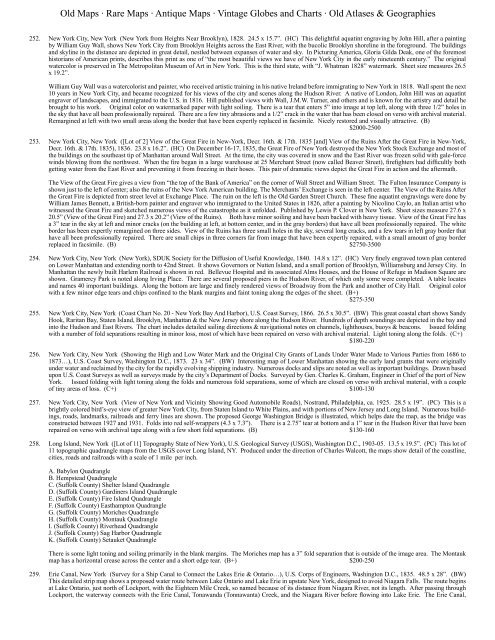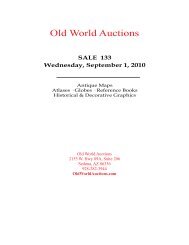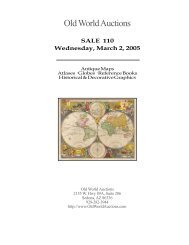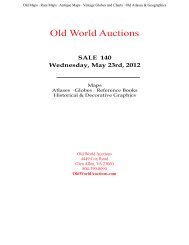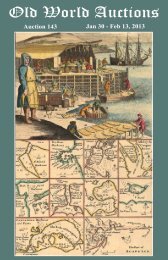<strong>Old</strong> Maps · Rare Maps · Antique Maps · Vintage Globes and Charts · <strong>Old</strong> Atlases & Geographies252. New York City, New York (New York from Heights Near Brooklyn), 1828. 24.5 x 15.7”. (HC) This delightful aquatint engraving by John Hill, after a paintingby William Guy Wall, shows New York City from Brooklyn Heights across the East River, with the bucolic Brooklyn shoreline in the foreground. The buildingsand skyline in the distance are depicted in great detail, nestled between expanses of water and sky. In Picturing America, Gloria Gilda Deak, one of the foremosthistorians of American prints, describes this print as one of “the most beautiful views we have of New York City in the early nineteenth century.” The originalwatercolor is preserved in The Metropolitan Museum of Art in New York. This is the third state, with “J. Whatman 1828” watermark. Sheet size measures 26.5x 19.2”.William Guy Wall was a watercolorist and painter, who received artistic training in his native Ireland before immigrating to New York in 1818. Wall spent the next10 years in New York City, and became recognized for his views of the city and scenes along the Hudson River. A native of London, John Hill was an aquatintengraver of landscapes, and immigrated to the U.S. in 1816. Hill published views with Wall, J.M.W. Turner, and others and is known for the artistry and detail hebrought to his work. Original color on watermarked paper with light soiling. There is a tear that enters 5” into image at top left, along with three 1/2” holes inthe sky that have all been professionally repaired. There are a few tiny abrasions and a 1/2” crack in the water that has been closed on verso with archival material.Remargined at left with two small areas along the border that have been expertly replaced in facsimile. Nicely restored and visually attractive. (B)$2000-2500253. New York City, New York ([Lot of 2] View of the Great Fire in New-York, Decr. 16th. & 17th. 1835 [and] View of the Ruins After the Great Fire in New-York,Decr. 16th. & 17th. 1835), 1836. 23.8 x 16.2”. (HC) On December 16-17, 1835, the Great Fire of New York destroyed the New York Stock Exchange and most ofthe buildings on the southeast tip of Manhattan around Wall Street. At the time, the city was covered in snow and the East River was frozen solid with gale-forcewinds blowing from the northwest. When the fire began in a large warehouse at 25 Merchant Street (now called Beaver Street), firefighters had difficultly bothgetting water from the East River and preventing it from freezing in their hoses. This pair of dramatic views depict the Great Fire in action and the aftermath.The View of the Great Fire gives a view from “the top of the Bank of America” on the corner of Wall Street and William Street. The Fulton Insurance Company isshown just to the left of center; also the ruins of the New York American building. The Merchants’ Exchange is seen in the left center. The View of the Ruins Afterthe Great Fire is depicted from street level at Exchange Place. The ruin on the left is the <strong>Old</strong> Garden Street Church. These fine aquatint engravings were done byWilliam James Bennett, a British-born painter and engraver who immigrated to the United States in 1826, after a painting by Nicolino Caylo, an Italian artist whowitnessed the Great Fire and sketched numerous views of the catastrophe as it unfolded. Published by Lewis P. Clover in New York. Sheet sizes measure 27.6 x20.5” (View of the Great Fire) and 27.3 x 20.2” (View of the Ruins). Both have minor soiling and have been backed with heavy tissue. View of the Great Fire hasa 3” tear in the sky at left and minor cracks (on the building at left, at bottom center, and in the gray borders) that have all been professionally repaired. The whiteborder has been expertly remargined on three sides. View of the Ruins has three small holes in the sky, several long cracks, and a few tears in left gray border thathave all been professionally repaired. There are small chips in three corners far from image that have been expertly repaired, with a small amount of gray borderreplaced in facsimile. (B) $2750-3500254. New York City, New York (New York), SDUK Society for the Diffusion of Useful Knowledge, 1840. 14.8 x 12”. (HC) Very finely engraved town plan centeredon Lower Manhattan and extending north to 42nd Street. It shows Governors or Nutten Island, and a small portion of Brooklyn, Williamsburg and Jersey City. InManhattan the newly built Harlem Railroad is shown in red. Bellevue Hospital and its associated Alms Houses, and the House of Refuge in Madison Square areshown. Gramercy Park is noted along Irving Place. There are several proposed piers in the Hudson River, of which only some were completed. A table locatesand names 40 important buildings. Along the bottom are large and finely rendered views of Broadway from the Park and another of City Hall. Original colorwith a few minor edge tears and chips confined to the blank margins and faint toning along the edges of the sheet. (B+)$275-350255. New York City, New York (Coast Chart No. 20 - New York Bay And Harbor), U.S. Coast Survey, 1866. 26.5 x 30.5”. (BW) This great coastal chart shows SandyHook, Raritan Bay, Staten Island, Brooklyn, Manhattan & the New Jersey shore along the Hudson River. Hundreds of depth soundings are depicted in the bay andinto the Hudson and East Rivers. The chart includes detailed sailing directions & navigational notes on channels, lighthouses, buoys & beacons. Issued foldingwith a number of fold separations resulting in minor loss, most of which have been repaired on verso with archival material. Light toning along the folds. (C+)$180-220256. New York City, New York (Showing the High and Low Water Mark and the Original City Grants of Lands Under Water Made to Various Parties from 1686 to1873…), U.S. Coast Survey, Washington D.C., 1873. 23 x 34”. (BW) Interesting map of Lower Manhattan showing the early land grants that were originallyunder water and reclaimed by the city for the rapidly evolving shipping industry. Numerous docks and slips are noted as well as important buildings. Drawn basedupon U.S. Coast Surveys as well as surveys made by the city’s Department of Docks. Surveyed by Gen. Charles K. Graham, Engineer in Chief of the port of NewYork. Issued folding with light toning along the folds and numerous fold separations, some of which are closed on verso with archival material, with a coupleof tiny areas of loss. (C+) $100-130257. New York City, New York (View of New York and Vicinity Showing Good Automobile Roads), Nostrand, Philadelphia, ca. 1925. 28.5 x 19”. (PC) This is abrightly colored bird’s-eye view of greater New York City, from Staten Island to White Plains, and with portions of New Jersey and Long Island. Numerous buildings,roads, landmarks, railroads and ferry lines are shown. The proposed George Washington Bridge is illustrated, which helps date the map, as the bridge wasconstructed between 1927 and 1931. Folds into red self-wrappers (4.3 x 7.3”). There is a 2.75” tear at bottom and a 1” tear in the Hudson River that have beenrepaired on verso with archival tape along with a few short fold separations. (B) $130-160258. Long Island, New York ([Lot of 11] Topography State of New York), U.S. Geological Survey (USGS), Washington D.C., 1903-05. 13.5 x 19.5”. (PC) This lot of11 topographic quadrangle maps from the USGS cover Long Island, NY. Produced under the direction of Charles Walcott, the maps show detail of the coastline,cities, roads and railroads with a scale of 1 mile per inch.A. Babylon QuadrangleB. Hempstead QuadrangleC. (Suffolk County) Shelter Island QuadrangleD. (Suffolk County) Gardiners Island QuadrangleE. (Suffolk County) Fire Island QuadrangleF. (Suffolk County) Easthampton QuadrangleG. (Suffolk County) Moriches QuadrangleH. (Suffolk County) Montauk QuadrangleI. (Suffolk County) Riverhead QuadrangleJ. (Suffolk County) Sag Harbor QuadrangleK. (Suffolk County) Setauket QuadrangleThere is some light toning and soiling primarily in the blank margins. The Moriches map has a 3” fold separation that is outside of the image area. The Montaukmap has a horizontal crease across the center and a short edge tear. (B+) $200-250259. Erie Canal, New York (Survey for a Ship Canal to Connect the Lakes Erie & Ontario…), U.S. Corps of Engineers, Washington D.C., 1835. 48.5 x 28”. (BW)This detailed strip map shows a proposed water route between Lake Ontario and Lake Erie in upstate New York, designed to avoid Niagara Falls. The route beginsat Lake Ontario, just north of Lockport, with the Eighteen Mile Creek, so named because of its distance from Niagara River, not its length. After passing throughLockport, the waterway connects with the Erie Canal, Tonawanda (Tonnawanta) Creek, and the Niagara River before flowing into Lake Erie. The Erie Canal,
<strong>Old</strong> Maps · Rare Maps · Antique Maps · Vintage Globes and Charts · <strong>Old</strong> Atlases & Geographieswhich was completed in 1825, stretches from Albany, NY on the Hudson River to Buffalo, NY on Lake Erie. This route was surveyed by Lieutenants T. F. Draytonand J. G. Reed under the direction of Capt. W. G. Williams, U.S. Topographical Engineers. Printed on two sheets, joined. Folding with minor offsetting, lightsoiling and a few creases. There are fold separations and tiny holes along folds that have been archivally repaired. There are 3” chips at left near the center andin bottom left corner that have been reattached with archival materials. (B) $180-220260. Steuben County, New York (Map of the County of Steuben), Burr, An Atlas of the State of New York, New York, 1829. 19.3 x 17.6”. (HC) This is an importantmap from the first individual state atlas published in the United States. It provides exquisite detail of each township and shows the progress of the surveys. It alsoidentifies stage and county roads, villages, flour and saw mills, forges, manufactories and churches. David Burr’s atlas of New York was the second atlas of anindividual state ever published; only Robert Mills’ 1825 Atlas of the State of South Carolina preceded it. The map was engraved by Rawdon Clark & Co. Albany& Rawdon, Wright & Co. N.Y. Ref: Ristow, pp. 103-106. Original color and wide margins with a few edge tears confined to the blank margins and some minorsoiling primarily confined to the blank margins. (B+) $350-450261. Oklahoma & Northern Texas (Asher & Adams’ Indian Territory and Texas. North West Portion), Asher & Adams, New York, 1874. 22.8 x 16.3”. (HC) This mapshows lands ceded to numerous Indian Tribes and was intended as a railroad map of Indian Territory. The Missouri-Kansas-Texas Railroad runs north-south alongthe eastern border of Indian Territory, and was the first railroad to enter Texas from the north, reaching Dallas by 1886. The proposed route for the Texas PacificRailroad is also shown, which was intended to extend between Marshall, TX and San Diego, CA, but instead was connected with the Southern Pacific Railroad atSierra Blanca, Texas in 1881. Light foxing and minor offsetting. (B+) $140-170262. Oklahoma (Map of Indian Territory [with report] Message from the President of the United States…in Relation to an Alleged Occupation of a Portion of theIndian Territory by White Settlers), Boudinot, Sen. Ex Doc No. 20 46th Cong., 1st Sess., Washington D.C., 1879. 22 x 15”. (PC) A desirable map depicting theterritory with the first designation of Public Lands. Included in a panel to the side of the map are two fascinating letters concerning the disposition of the PublicLands within the territory. The first, by Congressman Augustus Albert contains a list of questions. The answers, by Col. E.C. Boudinot, attempt to “set the recordsstraight” by detailing how the land was acquired from the Indians, its current status, and directions to “several million acres of the richest land on the continent.”A number of Army forts are named and located. Bound into the original 34 pp. report. A significant and important map for any Oklahoma collection. Near fine.(A) $275-350263. Oklahoma (Indian Territory Compiled under the Direction of Hon: John H. Oberly, Commissioner of Indian Affairs [with report] Letter from the Secretary of theInterior…Concerning the Legal Status of the Indians in Indian Territory), U.S. Bureau of Indian Affairs, Sen. Doc. 78, 51st Congress, 1st Session, Baltimore, 1889.31.8 x 23.6”. (PC) This colorful, detailed and informative map of present-day Oklahoma is sans its panhandle. Legends identify military reservations, Indianreservations, roads, trails, and railroads. Watershed and topography are well developed. Thirty-one different Indian lands are noted with information on pertinenttreaties and Executive Orders, all keyed to the map. Attractive and large sheet lithographed by A. Hoen & Co, Baltimore. Lot also includes the original 31 pagesof the related report “Letter from the Secretary of the Interior concerning the legal status of the Indians in Indian Territory.” There are a few tiny splits at foldintersections that have been closed on verso with archival tape. There is light toning along a few folds, minor foxing in right blank margin, and a binding trim andshort binding tear at lower left that has been closed with archival tape. The report is toned. (B+) $550-700264. Oklahoma (Map of Indian Territory and Oklahoma [with report] 11th Census of the United States: Indian Territory), U.S. Government, 11th Census, Report ofIndians Taxed and Indians Not Taxed, Washington D.C., 1890. 29.5 x 22”. (PC) Large, colorful and historically significant map showing the newly created OklahomaTerritory, which was created in 1889. This is possibly the only Census Office map showing the two territories together. Both would clamor for admission tostatehood. The Dawes Commission would soon extinguish Indian land titles, which led to eventual statehood for the Oklahoma Territory. There is documentarybackup for the Indian titles in each of the tribal areas and marginal notes with historical information on the various Indian Lands. Scale of 12 miles to the inch,legend in upper right. Lower right box lists the railroads authorized to operate in Indian Territory. This is the rarer issue from the 11th Census and should not beconfused with the more common General Land Office issue.Included with the map is the rarely seen accompanying text of the 11th census discussing Indian Territory. 76 pp. with 19 photographic plates including a fascinatingcolor plate of Scarfaced Charley. The map is disbound from the report and in near fine condition. The report has several loose pages and minor toning. (A)$600-750265. Oklahoma (The Oil Weekly Map of Oklahoma Showing Geological Districts, together with Producing Oil and Gas Fields…), The Oil Weekly, 1934. 19 x 16.5”.(PC) This map was published as a special supplement to the May 14, 1934 issue of The Oil Weekly. The red overprinting shows the locations of oil and gas fieldsin 10 geological districts with an inset of the western Oklahoma basin at lower left. Backed with tissue to repair and reinforce a number of small centerfoldseparations and edge tears with some minor pencil notations in the image. (B) $150-200266. Pennsylvania (William Penn’s Treaty with the Indians, When He Founded the Province of Pensylvania in North America 1681), Boydell, Philadelphia, [1775].23.3 x 18.2”. (BW) This important scene depicts William Penn entering into a peace treaty with a chief of the Lenape Indian tribe named Tamanend, under theshade of an elm tree near the village of Shackamaxon (now Kensington) in Pennsylvania. Under this tree, William Penn secured the purchase of land which wouldbecome the Commonwealth of Pennsylvania. Known as the Treaty of Friendship, Penn’s agreement with the Indians was an important example of Quaker values:the just and fair treatment of people from different cultures and religious beliefs. Engraved by John Hall and published by John Boydell.The engraving is based upon the original painting by Benjamin West in 1771 at the request of Thomas Penn, William’s son. West, who grew up in Swarthmore,Pennsylvania, trained in Philadelphia before moving to London. Since he did not have access to live Indians in England, West relied on his own sketches that werebased upon existing Italian sculptures. Later in his career, West was appointed President of the prestigious Royal Academy of Arts, being the first American tohold the position. Backed with old paper to infill a 0.75” hole to the right of the crowd, with image expertly drawn in facsimile. There are two repaired tears inthe image, and an unrepaired tear at left that just enters image. There is toning and a few tiny abrasions in the image, and foxing in the blank margins. (C+)$1600-2000267. Pennsylvania (Map of Pennsylvania, Constructed from the County Surveys Authorized by the State; and other Original Documents...Corrected & Improved to1826), Melish, Philadelphia, 1826. 73.5 x 42.5”. (HC) Although not the first map showing the full extent of Pennsylvania (which was created by Reading Howellcirca 1792), John Melish’s map is arguably the most important early map of the Keystone state. Melish was an experienced, skilled and energetic American cartographer,and received more official support and direction in his mapping of the state than his predecessor. In addition, Melish teamed up with engraver BenjaminTanner, one of the foremost American engravers of the early 19th century, to prepare the plates for his map.Melish was a strong believer in state financed cartography, asserting that individuals would not have the necessary resources or finances to properly maintain statemaps, and that state maps, therefore should be the official responsibility of the state. His comments were transmitted to influential legislators in Pennsylvania, whopassed an act in 1816 “Directing the Formation of a Map of Pennsylvania” and subsequently hired Melish to publish the map. The surveyor general contracted withdeputy surveyors to provide accurate maps of each county, which were then collected and sent to Melish for compilation into the state map. The map was finallyready for publication in 1822 after Melish and his assistants spent six years compiling the map, and Tanner spent another fifteen months engraving the plates. Themap was printed on six sheets, colored, available in several formats and mountings, and ranged in price from $9.00 to $12.50.Although Melish died on December 30, 1822, the state later issued revised versions of the map in 1824, 1826 and 1832. This map, with corrections to 1826, depictsthe counties on a scale of 5 miles per inch, as prescribed by the state legislature. Township boundaries, towns and cities, churches, roads, bridges, and grist millsare all depicted. The map extends to include New Jersey, Delaware, Maryland and Washington, D.C., but with less detail. At bottom are tables with the names ofthe surveyors who supplied each county map and statistical information on each county, as well as geological remarks and a legend. The title is surmounted by thePennsylvania coat of arms.Printed on six sheets, joined as issued. Backed with linen with wooden rollers attached and a ribbon tie closure. Ref: Ristow (Amer M&M) pp.110-115. Beauti-


